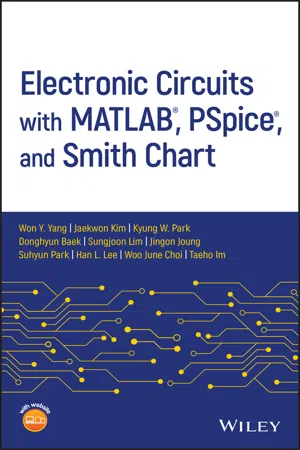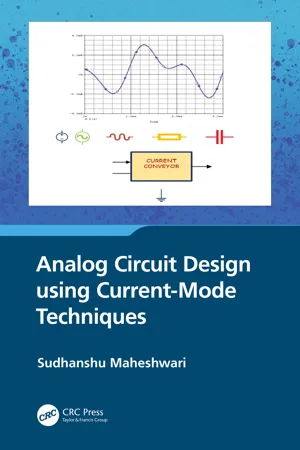Physics
Second Order Op Amp Circuit
A second order op amp circuit is a type of electronic circuit that utilizes operational amplifiers to create a system with a second order transfer function. This means that the circuit's output response is influenced by both the input signal and its rate of change. Second order op amp circuits are commonly used in filter designs and control systems due to their ability to provide more complex frequency response characteristics.
Written by Perlego with AI-assistance
Related key terms
Related key terms
1 of 4
Related key terms
1 of 3
3 Key excerpts on "Second Order Op Amp Circuit"
- Won Y. Yang, Jaekwon Kim, Kyung W. Park, Donghyun Baek, Sungjoon Lim, Jingon Joung, Suhyun Park, Han L. Lee, Woo June Choi, Taeho Im(Authors)
- 2019(Publication Date)
- Wiley(Publisher)
2 , respectively. Therefore, it has the transfer function as(5.5.2)This indicates that the OP Amp circuit in Figure 5.17 (b) works as a high‐pass filter (HPF) with the cutoff frequency of ωc= 1/R1 C and the DC gain of G(s)|s=0= 0.5.5.2 Second‐Order Active LPF/HPF
The transfer function of the Sallen‐Key circuit in Figure 5.18 (a) can be found by using the MATLAB function ‘SallenKey_xfer_ftn() ’ (introduced in Section 5.4.2 ) as>>syms s G1 G2 R3 R4 C1 C2 K >>Gs=SallenKey_xfer_ftn(G1,0,s*C1,G2,s*C2,(K-1)*R3,R3); pretty(simplify(Gs)) G1 G2 K - - - - - - - - - - - - - - - - - - - - - - - - - - - - - - - 2 G1 G2 + C1 G2 s + C2 G1 s + C2 G2 s + C1 C2 s - C1 G2 K sSecond‐order active (Sallen‐Key) filters.Figure 5.18This means that the transfer function G(s) is(5.5.3)This transfer function having only a constant term in the numerator indicates that the circuit will function as a low‐pass filter (LPF).The transfer function of the Sallen‐Key circuit in Figure 5.18 (b) can also be found by using the MATLAB function ‘SallenKey_xfer_ftn()- Sudhanshu Maheshwari(Author)
- 2023(Publication Date)
- CRC Press(Publisher)
Chapter 5 Higher order analog filtersDOI: 10.1201/9781003403111-5The coverage on analog circuit design using current-mode techniques has now brought us to a level where more complex analog circuits can be understood. The simple interfacing analog blocks and single time constant circuits have been studied, which form the foundation for higher order circuit design. This chapter deals with the second order filters operating in the voltage and current modes. The mixed mode filter circuits are also covered. The current-mode building blocks used are CCII, CCCII and EXCCII. The electronic tuning aspects are discussed and the filter circuits with such features are also described. The design of higher order filter circuits can then be attempted using second order and first order sections. The realization of circuits using commercially available current-mode ICs is presented, with interesting extension of the study for laboratory exercises. The behaviour of circuits considering the non-ideal active building block is studied. Illustrative examples are given along with real design examples showing graphical results using SPICE.5.1 Second order analog filters
The order of a filter decides the rate at which the gain magnitude and phase response changes with the frequency of the signal. The first order filter circuits are limited by their simplicity to offer slow change in their characteristics, both magnitude and phase. Confining to the magnitude, the first order filters’ gain magnitude changes by 20 decibels per decade change in frequency. It is expressed as 20 dB/decade. For the low-pass function it is –20 dB/decade, while for the high-pass function it is +20 dB/decade. The all-pass function is designed to maintain a constant gain magnitude. For the second order analog filters, the changes in characteristics are relatively faster than first order filters. The gain magnitude changes for low-pass and high-pass are −40 dB/decade and +40 dB/decade, respectively. Most of the analog filter theory revolves around the second order filter design, because the higher order filters can be realized using such filters in conjunction with first order sections. This is especially true for active-RC filters designed using the cascade approach, although various other approaches are available in voluminous subject related texts. The types of second order filters based on the selection or rejection of frequency ranges/bands are of interest. The low-pass, high-pass, band-pass, band-reject and all-pass are five such filter types. As per their names, the frequency selection/rejection is easy to co-relate. The same is illustrated by Figures 5.1 , 5.2 and 5.3 , which show typical second order gain magnitude functions of five such filters. Figure 5.1 shows low-pass, high-pass and band-pass; Figure 5.2 shows band-reject; and Figure 5.3- eBook - ePub
Introduction to Energy, Renewable Energy and Electrical Engineering
Essentials for Engineering Science (STEM) Professionals and Students
- Ewald F. Fuchs, Heidi A. Fuchs(Authors)
- 2020(Publication Date)
- Wiley(Publisher)
8 Operational Amplifiers8.1 Introduction
The operational (OP) amplifier is a basic building block for the design of analog electronic systems such as feedback control circuits [1 ], where the angular velocity ω m (t), angular position θ m (t) = ∫ω m (t)dt, current i(t), and torque T(t) must be controlled. An OP amplifier with no external circuitry is a voltage amplifier with a very high open‐loop voltage gain that ideally approaches infinity A v → ∞, as shown in a symbolic manner in Figure 8.1 . Note that input/output voltages can be either time varying or time independent, and they can be either periodic or nonperiodic.OP amplifiers are integrated circuits (IC), which can be purchased off the shelf, and they contain transistors, diodes, resistors, and capacitors all fabricated on a single silicon chip. Inductors are bulky and are mostly avoided in OP amplifier designs. The analog electronic circuit of Figure 8.1 has two inputs: a negative (v − ) and a positive (v + ) input supplied by the voltages v in1 and v in2 , respectively, whose difference in voltage (v in2 − v in1 ) produces an output signal voltage v out that is a replica of the input voltage difference. The two‐input voltage approach is useful because stray signals/electric noise that appear on both inputs are cancelled, and only the voltage difference is amplified. An OP amplifier is also called a differential amplifier because the output voltage is a voltage that is A v times the voltage difference between the two inputs. During the past half century, OP amplifiers have been refined and improved to the extent that they have nearly ideal properties, and therefore we discuss in this textbook the performance of ideal OP amplifiers only. The understanding of nonideal properties of OP amplifiers requires detailed electronic knowledge [2
Index pages curate the most relevant extracts from our library of academic textbooks. They’ve been created using an in-house natural language model (NLM), each adding context and meaning to key research topics.
Explore more topic indexes
Explore more topic indexes
1 of 6
Explore more topic indexes
1 of 4


